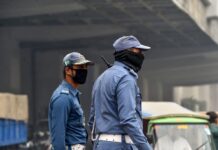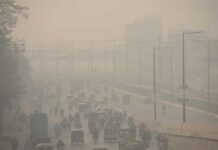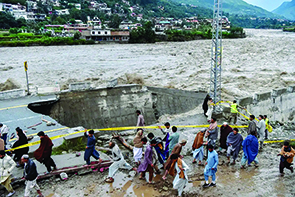Pakistan’s tryst with calamity has become a ritual of neglect. Each season brings familiar images— families perched on rooftops, bridges snapped like twigs, children wading through brown water that steals homes and futures— and each season the state performs its old pantomime: photo-ops, committees, and consolations.
The truth is unnerving but simple: disasters here are not purely natural; they are administered. The latest devastation across Khyber Pakhtunkhwa, Gilgit-Baltistan, and AJK once again exposes the same fault lines— elite complacency, bureaucratic inertia, and governance designed more for optics than outcomes. Even as cloudbursts and flash floods tore through northern Pakistan in mid-August 2025, killing hundreds in KP alone, official tallies lagged reality and the response lagged need. The spectacle repeats, the losses deepen, and the lessons go unlearned.
We have been warned by history— loudly. The 2010 “super floods” affected roughly one-fifth of Pakistan’s land mass, killed about 1,985 people, and directly impacted around 20 million citizens. It was not merely a meteorological crisis; it was a governance test we failed, spectacularly and publicly. Post-disaster assessments at the time already stressed that Pakistan had suffered eight severe floods since independence, with more than 8,000 deaths and 100,000 villages affected— yet our reconstruction choices rarely matched the slogan of “build back better,” defaulting instead to a cheaper, slower, more corruptible “build back the same.” We rebuilt vulnerabilities, not resilience.
Then came 2022, a curtain-raiser for a more volatile climate future. A third of the country seemed under water; 33 million people were affected, over 1,700 lives lost, damages and economic losses estimated above $30 billion in the World Bank/ADB/UN-supported assessments, with reconstruction needs upwards of $16 billion just to restore what was broken— never mind what must be fortified. Pakistan secured pledges of roughly $9 billion in Geneva, but much of it was loans, not grants, swelling an already stressed fiscal artery while millions remained in tents or makeshift shelters well into 2024–25. If the measure of a state is how it shields the vulnerable, then by that measure we remain unprepared, unserious, and unfair.
This is not ignorance; it is elite indifference. Our political class finds refuge in euphemism— “nature’s wrath,” “unprecedented rainfall”— as if deforestation, riverbed encroachments, shoddy drainage, and unregulated construction were acts of God rather than acts of governance. Hill towns are paved into heat-catching, runoff-accelerating concrete; floodplains are licensed into speculative real estate; stormwater systems are afterthoughts. Where are the district-level drills, the stocked warehouses, the trained volunteer corps, the sirens that actually sound before the water arrives? Pakistan’s own legal architecture says the district authority is the planning, coordinating, and implementing body for disaster risk management. Yet a statute on paper cannot pull a child from the torrent; only capability can. When capability is absent, every cloudburst becomes a referendum on our priorities— and a verdict of guilt.
The mountains now carry a different kind of messace. Pakistan hosts more than 7,000 glaciers and over 3,000 glacial lakes; with at least 33 of these lakes classified as hazardous. Millions in GB and KP live under the down-slope shadow of glacial lake outburst floods (GLOFs), where a single moraine breach can unleash walls of water and debris in hours. UNDP’s GLOF-II was designed to scale early-warning systems, community training, protective engineering, and climate-risk planning from two pilot districts to ten. That is the correct direction— but the physics of warming is racing ahead of our politics of delay. When early-warning towers are unpowered, when community evacuation maps sit in office drawers, when protective works are half-built as budgets stall, risk converts instantly into tragedy.
If the pattern feels relentless, it’s because recovery has been politicized and financialized. After the 2022 floods, much of the promised support materialized as loans. Meanwhile, families waited as procurement delayed, land titles were disputed, and inflation erased budgets mid-project. The result is a recovery that drags on, with too many people still in transitory structures when the next monsoon arrives. Climate loss-and-damage debates may rage in international forums, but for a woman in Buner or a farmer in Dadu, the debate is not theoretical; it is the price of a roof and the certainty of clean water.
Call it what you will— bad luck, climate injustice, a cruel geography— but the hardest truth is this: the difference between hazard and catastrophe is governance. Floods will come; cloudbursts will strike; glaciers will melt. Whether they become mass funerals or managed emergencies depends on whether Pakistan can finally dethrone the theatre of announcements and enthrone the discipline of readiness. Until that day, every monsoon will read like a charge sheet, and every swollen river will mirror our worst failing— not that we were warned too late, but that we refused to learn in time.
So let’s say plainly what the euphemisms hide. Pakistan does not lack institutions; it lacks institutional performance. We have a National Commission, a National Authority, Provincial DMAs, District Authorities, policy frameworks, and glossy plans updated as recently as 2024. But performance is measured where the flood reaches— at the culvert, the bridge, the school-shelter, the telecom tower, the warehouse, the last mile of a siren’s sound. Until budgets are ring-fenced for district-level readiness; until annual drills are mandatory and audited; until local governments are funded to stock amphibious boats, satellite phones, and portable pumps; until encroachments on flood channels are criminally prosecuted rather than politically protected; until environmental impact assessments are enforced rather than negotiated—until then, disaster management will remain a press release, not a protection.
This is not a counsel of despair; it is a demand for sobriety. Bangladesh’s community-based flood preparedness shows what disciplined, localized systems can achieve with fewer resources than ours. Pakistan can do the same— by converting federal frameworks into district muscle; by empowering communities with drills, radios, and evacuation routes; by making resilience a line item, not a slogan; by linking reconstruction finance to build-back-safer standards that cannot be politically waived. In Swat, one family lost in minutes is not an anecdote; it is an indictment. In KP this August, hundreds dead is not a statistic; it is a national embarrassment. We know what works. We simply have not chosen it with the urgency that survival requires.
Call it what you will— bad luck, climate injustice, a cruel geography— but the hardest truth is this: the difference between hazard and catastrophe is governance. Floods will come; cloudbursts will strike; glaciers will melt. Whether they become mass funerals or managed emergencies depends on whether Pakistan can finally dethrone the theatre of announcements and enthrone the discipline of readiness. Until that day, every monsoon will read like a charge sheet, and every swollen river will mirror our worst failing— not that we were warned too late, but that we refused to learn in time.























